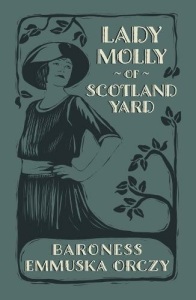
By 1910 Baroness Orczy’s most famous invention, The Scarlet Pimpernel, had made a trio of appearances. The author was obviously feeling that it was time for a female protagonist to take the stage. The time was also right for someone to give Sherlock Holmes, who had appeared 6 times up to that time, a run for his money. Enter Lady Molly and her sidekick Mary Granard. This was groundbreaking in more ways than one. Not only was Lady Molly one of the first fictional female detectives, she preceded the first real-life female detective at Scotland Yard by a decade!
Now it was a risk me suggesting this title as a buddy read with my #ReadIndies co-hostess, Karen, because I cannot stand Sherlock Holmes. He’s such an arrogant know-it-all. Would Lady Molly be a character from the same mould? Well, yes … and no. Her intelligence is vastly superior to her Watson-like sidekick, Mary, and she can concoct a correct hypothesis from thin air at times. She calls that female intuition, something that leaves her male counterparts trailing in her wake. She also has an abundance of charm. It’s a rare person who doesn’t fall under her spell (even I did … eventually.)
No-one, but no-one, is as spell-bound as her maid and friend, Mary Granard, the narrator of the 12 stories in the collection. Lady Molly can do no wrong, even though to outside eyes she behaves atrociously towards Mary, taking her entirely for granted, sending her, often with no notice, on one errand after another, disguise de rigueur, delighting (it seems to me) in keeping Mary in the dark. Mary, who has developed “obedience to the level of a fine art”, is putty in the hands of Lady Molly and thus her narration is dripping with what amounts to heroine-worship.
So Lady Molly is brilliant, beautiful, vastly more intelligent than her male colleagues, and always right.
Her method is to form her hypothesis and then work towards proving it right, flushing out the culprits, not always ethically. In fact Mary does occasionally hint that her bosses did not always approve of her methods. Nevertheless whether it is by means of placing false articles in newspapers, initiating situations that nowadays might constitute entrapment, or just by being 10 steps ahead of others due to her intuition, Lady Molly gets results, and quickly becomes the go-to detective when a case proves particularly tricky.
In most cases all Lady Molly has to do is follow the money: many of these crimes relate to inheritance or rather disinheritance. There seems to have been a lot of feckless sons and nephews around in 1910! The stories are period pieces with certain attitudes of the time prevalent. For example the poor are blamed for being poor, derided for wearing ragged clothing etc. There’s no criticism reserved for those who pay the meagre wages that make such existences a necessity. And given the constant put-downs of Lady Molly’s male colleagues, couldn’t valid charges of sexism be raised? Nah. That’s all a bit ponderous for me. Besides not all the villains are male. There are female blackmailers, poisoners and art thieves behaving nefariously too.
Admittedly the stories follow a similar pattern but they’re just the right length for sitting down to enjoy with a pot of tea minus postmodern criticism. Story eleven brings a surprising twist. For all Mary’s heroine-worship we don’t learn much about Lady Molly’s backstory until now. The revelation of the personal motivation behind the honing of her detective skills is quite something. Of course she’s going to solve the case on which hinges her future happiness. After which she hangs up her detective boots.
Now that’s interesting. I wonder why Baroness Orczy chose to write a one-off and not turn her lady detective into a franchise?

Lady Molly of Scotland Yard is published by Renard Press, winner of the 2023 Ola Gotkowska Young Independent Publisher Award, and a current Small Press of the Year Regional Finalist in the 2024 British Book Awards.
My interview with Will Dady, founder of Renard Press and The Independent Press Network, opened #ReadIndies 2024 and highlighted the pleasures and pains of being a small independent publisher in today’s challenging climate. I hope that the reviews from myself, my cohostess, Karen and our cohort of fellow bloggers produced during #ReadIndies 2024 highlight both the variety and the quality of material available from small presses to a larger audience and help our favourite indies survive. Bookshelves would be less stimulating without them.
The full index of #ReadIndies 2024 reviews will be available early next week.

I’m glad you fell under her spell, Lizzy – totally agree that is the perfect escape from the horrors of modern living! I didn’t quite expect the ending of the stories, and like you wonder why Orczy didn’t carry on with these. But I did enjoy them.
LikeLiked by 1 person
It took a while for the spell to work it’s magic. Didn’t happen until I understood her personal motivations.
LikeLiked by 1 person
I think I would enjoy this.
I do love Sherlock Holmes though.
LikeLike
I’m thinking I should perhaps give Sherlock a second chance ….
LikeLiked by 2 people
I’ve been meaning to read Lady Molly since I saw her referenced somewhere, but who was it? was it Agatha Christie’s Tuppence? I can’t remember but thank you for reminding me to read her, and I think I’ll enjoy it.
LikeLike
Karen’s review got me interested and now I really have to read this! I’m so curious now about the motivation you mention. It is a good question why the author limited it to one book. Maybe she thought she could not keep it up for some reason?
LikeLike